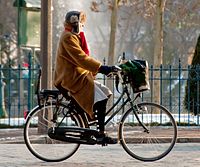
Photo from wikipedia
Background: Although walking for travel can help in reaching the daily recommended levels of physical activity, we know relatively little about the correlates of walking for travel in the European… Click to show full abstract
Background: Although walking for travel can help in reaching the daily recommended levels of physical activity, we know relatively little about the correlates of walking for travel in the European context. Objective: Within the framework of the European Physical Activity through Sustainable Transport Approaches (PASTA) project, we aimed to explore the correlates of walking for travel in European cities. Methods: The same protocol was applied in seven European cities. Using a web-based questionnaire, we collected information on total minutes of walking per week, individual characteristics, mobility behavior, and attitude (N=7,875). Characteristics of the built environment (the home and the work/study addresses) were determined with geographic information system (GIS)-based techniques. We conducted negative binomial regression analyses, including city as a random effect. Factor and principal component analyses were also conducted to define profiles of the different variables of interest. Results: Living in high-density residential areas with richness of facilities and density of public transport stations was associated with increased walking for travel, whereas the same characteristics at the work/study area were less strongly associated with the outcome when the residential and work/study environments were entered in the model jointly. A walk-friendly social environment was associated with walking for travel. All three factors describing different opinions about walking (ranging from good to bad) were associated with increased minutes of walking per week, although the importance given to certain criteria to choose a mode of transport provided different results according to the criteria. Discussion: The present study supports findings from previous research regarding the role of the built environment in the promotion of walking for travel and provides new findings to help in achieving sustainable, healthy, livable, and walkable cities. https://doi.org/10.1289/EHP4603
Journal Title: Environmental Health Perspectives
Year Published: 2019
Link to full text (if available)
Share on Social Media: Sign Up to like & get
recommendations!